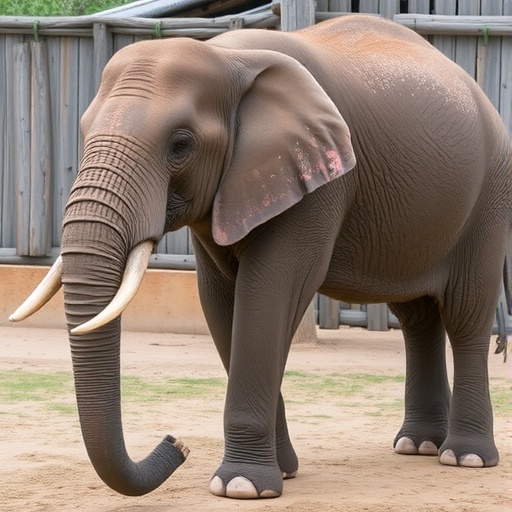In the world of wildlife conservation, the management of health conditions in captive animals has garnered significant attention. A recent study published in the journal “Discovery Animal” highlights an intriguing case of successful management of verrucous granuloma in a captive Asian elephant (Elephas maximus). This condition, characterized by raised, wart-like growths on the skin, can significantly impact the well-being of these majestic creatures. The research team, led by experts Giggin, Martin, and Venugopal, embarked on a journey to address this challenging condition and the implications it has on animal care within zoological settings.
The study focuses on a female Asian elephant residing in captivity, which developed verrucous granulomas in various areas of her body. These growths not only pose health risks but can also complicate the daily care regimes that veterinarians and zookeepers must adhere to. The team identified the need for an integrative approach that encompassed both medical treatment and modifications in the elephant’s environment to mitigate the exacerbation of this condition. Their findings shed light on how interdisciplinary collaboration can lead to more effective treatments and improve the animals’ quality of life.
Verrucous granuloma is often a response to chronic irritations or infections, and in the case of elephants, it might be influenced by various factors such as habitat, diet, and the presence of other animals. The research highlighted the importance of meticulous observation and ongoing assessment of the elephant’s condition to employ timely interventions. Gathering comprehensive data on the growths allowed the veterinarians to strategize a management plan that was both effective and sustainable.
The medical management of the verrucous granuloma involved a combination of topical treatments and surgical interventions. The research team effectively utilized a well-defined regimen that included antiseptic solutions and anti-inflammatory medications, which collectively contributed to the reduction of the growths’ size and severity. The surgical procedures were performed in a way that prioritized the elephant’s well-being, ensuring minimal stress during recovery. The authors emphasized that understanding the animal’s anatomy and behavior was crucial in making informed decisions throughout this process.
Moreover, the study underscores the role of environmental enrichment in the management of health conditions in captive animals. The rehabilitation efforts were complemented by changes made to the elephant’s habitat, including the introduction of sensory stimuli that encouraged natural behaviors. The research suggests that unique, engaging environments can promote mental and physical health, playing an integral role in the healing process. This holistic approach aligns with the overarching goal of promoting well-being and minimizing clinical issues that can arise in captive settings.
The use of advanced veterinary techniques and proactive health management protocols represents a significant step forward in the care of elephants in captivity. The study articulates the necessity for ongoing education and training for zookeepers and veterinarians, as well as a commitment to the continuous improvement of health care practices. This commitment is not merely about treating illness but involves fostering a preventive culture that appreciates the unique traits and needs of such large, intelligent mammals.
In detailing the veterinary care provided, the research also noted the collaboration with a multidisciplinary team, including specialists in dermatology and behavioral science. This collaborative effort is vital as it combines different areas of expertise, yielding a comprehensive view of the elephant’s health and behavior. The interactions between the medical and behavioral components of care were essential to the successful management of the verrucous granuloma.
The findings of this research not only have implications for captive Asian elephants but can also resonate across various species that experience similar dermatological conditions. Hence, the research advocates for the standardization of protocols that can be adapted to meet the diverse needs of different species in captivity. It encourages wildlife care facilities to share insights and approaches, creating a network of knowledge that can lead to widespread improvement in animal care.
As wildlife conservation continues to evolve, the case study highlights a growing emphasis on welfare-oriented practices that prioritize the physical and psychological health of the animals. The success of managing verrucous granuloma in this captive setting illustrates what is attainable when dedication and advanced veterinary practices converge. Conservationists and zoological professionals are now motivated to consider new methodologies to improve animal welfare actively.
As the research progresses, the implications extend beyond the walls of the zoo and challenge current practices within wildlife management and conservation. This study aims to build a case for better animal care policies, paving the way for more effective protocols that may one day be embraced as the gold standard in wildlife rehabilitation. By documenting and sharing these experiences, the scientific community can fuel further studies that could benefit countless animals in captivity.
In conclusion, the case of the verrucous granuloma in a captive Asian elephant stands as a testament to the advancements in veterinary medicine and the commitment to animal welfare. It invites future researchers to investigate and develop innovative ways to tackle common health issues faced by wildlife, ensuring that these magnificent beings not only survive but thrive in human care. The hope is that more success stories will emerge, ultimately leading to enriched and extended lives for elephants and other species in similar situations.
With an eye on the future and an ear attuned to the voices of our fellow creatures, the ongoing mission remains clear: to promote health, welfare, and dignity for all animals under human care.
Subject of Research: Successful management of verrucous granuloma in captive Asian elephants.
Article Title: Successful management of verrucous granuloma in a captive Asian elephant (Elephas maximus).
Article References:
Giggin, T., Martin, K.D.J., Venugopal, S.K. et al. Successful management of verrucous granuloma in a captive Asian elephant (Elephas maximus). Discov Anim 2, 71 (2025). https://doi.org/10.1007/s44338-025-00129-z
Image Credits: AI Generated
DOI: 10.1007/s44338-025-00129-z
Keywords: verrucous granuloma, Asian elephant, animal welfare, veterinary medicine, conservation efforts.





